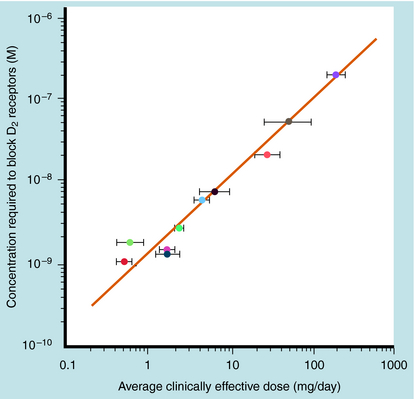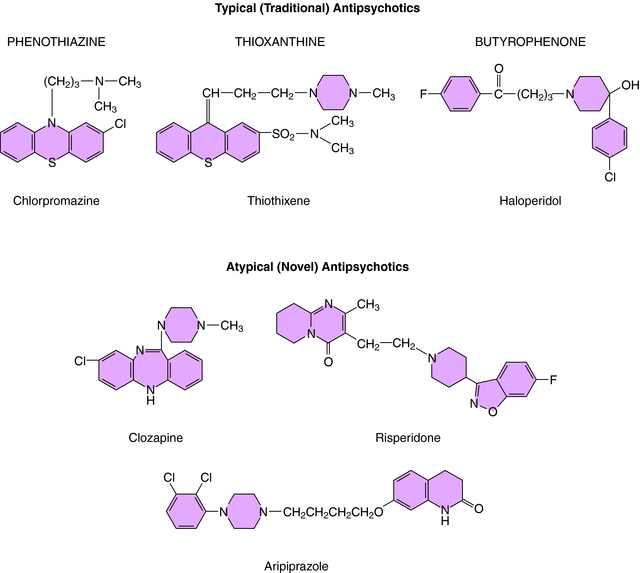Chapter 29 Treatment of Psychotic Disorders
| Abbreviations | |
|---|---|
| ACh | Acetylcholine |
| DA | Dopamine |
| 5-HT | Serotonin |
Therapeutic Overview
| Therapeutic Overview |
|---|
| Typical Antipsychotics |
| Alleviate positive symptoms |
| Bind to and block 70% to 80% of D2 receptors at clinically effective doses |
| Atypical Antipsychotics |
| Alleviate positive and may improve negative symptoms |
| May improve cognitive impairments |
| Bind to and block 40% to 60% of D2 receptors at clinically effective doses |
| Bind to and block 70% to 90% of 5-HT2A receptors at clinically effective doses |
Mechanisms of Action
The typical antipsychotics comprised the first group of compounds developed for the treatment of schizophrenia. Based on chemical structure, these compounds fall into three groups (Fig. 29-1):
The effects of the typical antipsychotics are due to blockade of postsynaptic DA receptors, specifically D2 receptors. Indeed, a positive linear correlation exists between the therapeutic potency of typical antipsychotics and their ability to bind to and block D2 receptors (Fig. 29-2). Inhibition of these receptors in mesolimbic and mesocortical regions (see Fig. 27-8) is believed to mediate the ability of these compounds to relieve some behavioral manifestations of schizophrenia. On the other hand, blockade of these receptors in the basal ganglia underlies the motor side effects of these compounds, and inhibition of these receptors in the tuberoinfundibular pathway in the hypothalamus leads to increases in prolactin secretion from the pituitary gland.

FIGURE 29–2 Correlation between the therapeutic dose of antipsychotics and the concentration to block D2 receptors.
Acute administration of the typical antipsychotics increases the firing rate of both mesolimbic and nigrostriatal DA neurons as a compensatory response to DA receptor blockade. However, long-term administration inactivates these pathways via depolarization blockade. Because the therapeutic effects of the typical antipsychotics require several weeks to become apparent, it is believed that this inactivation of mesolimbic DA neurons mediates the time-dependent amelioration of psychotic symptoms. Long-term administration of antipsychotics also leads to an up regulation of DA receptors as a consequence of the depression of DA activity.
The atypical antipsychotics represent a somewhat heterogeneous group of compounds with large differences in chemical structure (see Fig. 29-1), receptor antagonist activity, and therapeutic and side effect profiles. These compounds vary more in potency and range in treating specific symptoms as compared with the typical compounds. As heterogeneous as the group is, however, these compounds share several commonalities. They all occupy and block fewer D2 receptors than the typical antipsychotics (40% to 60% as compared with >70% to 80%), and they all block a high number (70% to 90%) of 5-HT2A receptors. Because of their lower occupancy of D2 receptors, the atypical antipsychotics have a lower propensity than the typical compounds to induce motor side effects. In addition, they may have an increased ability to alleviate the negative symptoms of schizophrenia, and the rate of relapse is lower than that after administration of typical antipsychotics.
Stay updated, free articles. Join our Telegram channel

Full access? Get Clinical Tree



